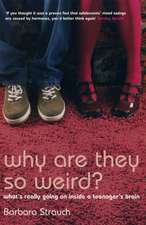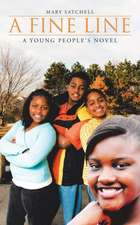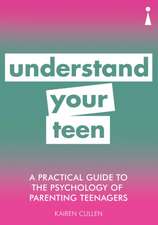The Primal Teen: What the New Discoveries about the Teenage Brain Tell Us about Our Kids
Autor Barbara Strauchen Limba Engleză Paperback – 31 aug 2004
Preț: 106.45 lei
Nou
Puncte Express: 160
Preț estimativ în valută:
20.37€ • 21.19$ • 16.82£
20.37€ • 21.19$ • 16.82£
Carte disponibilă
Livrare economică 24 martie-07 aprilie
Preluare comenzi: 021 569.72.76
Specificații
ISBN-13: 9780385721608
ISBN-10: 0385721609
Pagini: 256
Dimensiuni: 128 x 211 x 14 mm
Greutate: 0.23 kg
Ediția:Anchor Books.
Editura: Anchor Books
ISBN-10: 0385721609
Pagini: 256
Dimensiuni: 128 x 211 x 14 mm
Greutate: 0.23 kg
Ediția:Anchor Books.
Editura: Anchor Books
Notă biografică
Barbara Strauch, was a reporter and newspaper editor who directed health and science coverage for The New York Times for a decade. Prior to joining The New York Times, she had covered science and medical issues in Boston and Houston and directed Pulitzer Prize-winning news at Newsday. She was also the author of two books about the brain.
Barbara Strauch died in 2015 at the age of 63.
Barbara Strauch died in 2015 at the age of 63.
Extras
Chapter 1
Crazy by Design
The New Science of the Teenage Brain
Teen. Brain. Brain. Teen. The words, I concede, go more tongue in cheek than hand in hand. Utter them out loud--mention even that you're writing a book on the teenage brain--and the jokes come popping out, like pimples before a prom.
"What? They have one?"
"Short book."
Steve, the father of two teenage boys, shook his head and wished me luck. As far as he could tell, the teenage brains he knew had recently and inexplicably gone berserk.
"I don't get it," he said. "All of a sudden strange things are happening with the kids we know. These are good kids, bright kids, but the other day one stole some calculators from the high school and sold them, another can't finish any homework. Getting my own kids out the door in the morning now is this monumental thing. What's going on?"
Denise, a writer and the mother of two lovely teenage boys, was ferocious.
"Teenage brain? I'll tell you teenage brain," she told me one morning. "You know my thirteen-year-old? Well, he went to the school dance, and the rule is you have to stay inside and you can't leave. But he and his friends decided they were imprisoned, and so they went outside and ran in a big circle around the gym. Who knows what they were thinking, but the principal found out and called my husband at home. The next day, we talked and talked; we told him he had to apologize, that he had inconvenienced everyone. But he just couldn't get it; he couldn't get outside himself to understand things from someone else's point of view."
And what was next from this thirteen-year-old, a straight-A kid who never caused a speck of trouble before and who, as his mother says, "used to be so meticulous and quiet and sweet?"
One evening, Denise came home from work and found three letters waiting for her: One said her son had, as expected, been put on the honor roll, the second said he'd made all-county orchestra, and the third said he was being suspended from school after being caught hanging around downtown when he was supposed to be in history class.
"You look at them and sometimes they're so articulate and they seem so grown up and you think they have all the pieces, but sometimes they just don't," said Denise. "I have to say that I believed, smugly, that only irresponsible, self-absorbed jerks had children who got into trouble. But something always happens. It's annoying; it's scary; it can make you crazy."
As the mother of two teenage girls, I don't quibble with this. Annoying stuff happens, scary stuff happens. It can make you crazy.
One morning not long ago my oldest daughter, then fifteen, got up (at noon) and to my delight--without being asked!--cleaned her room and lugged her laundry to the washing machine.
Then, as the rinse cycle whirred and we talked in the living room--I suggested that it wasn't such a great idea to take her new CD player to an amusement park with water rides--she morphed, she mutated. Shooting up off the couch--in full-tilt pubescent display--she stomped upstairs, flinging over her shoulder the battle cry of the teenage warrior goddess, circa 2003: "You suck!"
The world, of course, has been trying to figure out teenagers for centuries. Their behavior has baffled the best of our thinkers. Aristotle said teenagers appeared "fickle in their desires," which are as "transitory as they are vehement." Shakespeare, Romeo and Juliet aside, described adolescence as largely a time for "getting wenches with child, wronging the ancientry, stealing, fighting." And, if he spoke of their brains at all, which was rare, he dismissed them as "boiled."
The first whiff from those boiled brains can be subdued, even subtle.
Rhona, the mother of two teenagers in New Jersey, knew her daughter Susannah was a teenager simply because she "became embarrassed about the music I had on in the car." Bill, the father of two teenage girls in a small town in New York, says he knew adolescence had arrived when one of his daughters didn't speak to him for a week. Ron, the father of four teenagers in Phoenix, always knew one of his kids had hit adolescence when they started spending a lot of time in the bathroom.
Other times, the whiffs become shock waves.
One father in Minneapolis was aghast when his straitlaced son was caught painting graffiti on the side of a store; a mother in Princeton got a call one spring afternoon from the local police who said her well-behaved fourteen-year-old daughter had stolen a T-shirt from the mall; a mother and father were in tears when their beautiful fifteen-year-old daughter sneaked out her window at midnight to meet a twenty-four-year-old man she'd just met.
For Ellen in New York City, the mother of twin boys, the adolescent wave that swept into her house was abrupt, swift, and "horrible." It arrived about the time her sons were in the seventh grade. "To me it was a return to the terrible twos," she told me. "The tantrums, the stomping of feet, the slamming of doors, the fighting, the name-calling, the animalistic behavior. All of a sudden they got very good at evasive behavior, experts at keeping secrets. Their rooms were a mess, their bodies were clean but they had laundry all over the floor. They became very rude and the self-involvement was breathtaking. It was cosmos-annihilating narcissism, that's what it was."
One son tiptoed out of the family's apartment late at night and somehow got himself to New Jersey with his friends; the other--both boys are quite smart--was caught after he hacked into a university computer system. One--no need to say which--managed to make LSD in the high school science lab.
"Believe me, it was a struggle," said Ellen. "I knew all about how teenagers were supposed to be, but still, it knocked me out."
Teenagers themselves are often surprised at how rapidly their world changes, in all sorts of ways. Lisa, a fourteen-year-old girl from Minneapolis who plays lacrosse and actually likes studying Latin, told me it seemed that "all of a sudden" her moods "were all over the place."
"Sometimes, I just get overwhelmed now," she said. "There's all this friend stuff and school and how I look and my parents. I just go in my room and shut the door. My parents want to talk to me, and I don't mean to be mean, but sometimes I just have to go away and calm down by myself."
This is not to say that all teenagers are alike. Parents often describe at least one child, more if the gods smiled, who just seemed to sail through adolescence. But for most teenagers, blessed with natural curiosity and transversing unknown emotional, physical, and hormonal lands, something usually happens, nothing malicious, nothing illegal, just something.
"I get in trouble a lot more now, but it's for stuff I really didn't mean," said Martin, fifteen. "I forget to call home. I don't know why. I just hang out with friends, and I get involved with that and I forget. Then my parents get really mad, and then I get really mad, and it's a big mess."
What's Going On?
So what's really happening? Why do normal, well-behaved teenagers start pouting in their rooms, sneaking out windows, stomping their feet, or making LSD in the school science lab? For many years, the answer had been simple: hormones, the raging hormones of adolescence.
I remember, not long ago, going to an orientation for my daughter when she was entering sixth grade, and listening to the white-haired principal get a good laugh when he told the crowd of jittery parents sitting in front of him on folding chairs: "Don't worry, we know that all the growth in these middle school years goes on--from the neck down."
He was only partly right. No question, there's unmistakable activity from the neck down in the teenage years. No question, testosterone is there skateboarding down the railings; estrogen is throwing her hips around.
But that's not the whole story.
For the first time now, scientists are starting to look beyond hormones to explain teenage behavior. And they're finding clues in an unexpected place: the teenage brain, the boiled, besmirched--and decidedly above the neck--teenage brain.
For years it was thought that the teenage brain was finished, cooked. Most of the truly important human brain development, scientists believed, was over by the first three years of life. Explaining teenagers has been the job of social scientists, psychologists, psychiatrists, educators, and maybe a priest or two, not neuroscientists. What possible interest could still lurk behind those pierced eyebrows, under that orange-spiked hair?
As it turns out, a whole lot.
In unprecedented work, scientists are discovering exactly how the teenage brain works. Using powerful new brain-scanning machines, peering for the first time into living, working teenage brains, coordinating work across countries and across continents, drawing on pioneering work with adolescent primates and even rats, the neuroscientists are finding that the teenage brain, far from being an innocent bystander to hormonal hijinks, is undergoing a dramatic transformation.
The teenage brain, it's now becoming clear, is still very much a work in progress, a giant construction project. Millions of connections are being hooked up; millions more are swept away. Neurochemicals wash over the teenage brain, giving it a new paint job, a new look, a new chance at life. The teenage brain is raw, vulnerable. It's a brain that's still becoming what it will be.
"We used to think that, if there were brain changes at all in adolescence, they were subtle," Elizabeth Sowell, a neuroscientist at UCLA and one of the country's top researchers of the adolescent brain, told me. "Now we know that those changes are not as subtle as we thought. Every time we look at another set of teenage brains, we find something new."
And this growing group of neuroscientists--in some cases with teenagers of their own they need to figure out--are uncovering clues that can help us all understand why teenagers do what they do, zeroing in on what the normal, average teenage brain might be up to during what one normal, average seventeen-year-old-girl described as her "brief insanity."
The portrait is far from one-dimensional.
The teenage brain may, in fact, be briefly insane. But, scientists say, it is crazy by design. The teenage brain is in flux, maddening and muddled. And that's how it's supposed to be.
And the teenage brain is also wondrous. It's the brains of teenagers, after all, that begin to grapple with our knottiest, most abstract concepts, with honesty and justice. In the neuronal nooks and crannies of their evolving brains, teenagers, for the first time, develop true empathy. They may find themselves, often to their own surprise, happy to stay up until three a.m. to listen to a friend in trouble, worrying about the children in war-torn Afghanistan, or passionately falling in love with the nuances of a poem.
"I love teenagers," said a mother whose two children had successfully navigated their teenage years. "I like their intelligence and their growing ability to think for themselves, to argue intelligently, and get excited by ideas. I like sharing books with them and I like the way they can show me things, like how to use a Palm Pilot. And I like their sense of style."
In their own way, the brain scientists, too, have detected this polysided adolescence, a normal brain evolution that includes moments of mayhem as well as growing precision and passion. Inside the teenagers' brains--smart ones, shy ones, silly ones--they've found, and this word comes from the neuroscientists' own ungainly language, exuberance.
Chapter 2
The Passion Within
Peering into the Living Brain in Search of Normal
Nora loped through the clinic door, her long brown hair with a wide purple streak flowing behind her. In recent years, Nora Berenstain had survived a move from Sacramento to Washington, D.C., her parents' divorce, and a horrific seventh grade when her best friend moved away.
Now sixteen, Nora was confident and instantly likable. She volunteered at NOW headquarters and helped edit the school paper. Wearing faded jeans and a flowered shirt, she flopped her tall, thin body down on a chair and burst out: "How ya doin', Dr. Giedd?"
David and Matthew Goldstein, thirteen-year-old twins, came next, bounding in like matching soccer balls. It was their first time at the clinic and they blurted nervous questions. "This machine, what exactly is it going to do, Dr. Giedd?" asked Matthew.
Dr. Jay Giedd, the forty-year-old neuroscientist at the National Institutes of Health (NIH) who they'd come to see, is one of a small group of scientists who have recently discovered that the brains of regular, average teenagers like Nora and David and Matthew are far different from what anyone had imagined.
A child psychiatrist, a neuroscientist, and the father of four young kids himself, Giedd is originally from North Dakota. He has an open, round face, a short red beard, and he grinned broadly as each teenager arrived at his clinic trying, with one of his corny North Dakota jokes, to get them to laugh." Oh, I love your hair," he told Nora when he saw her purple streak. He patted his own balding head. "I wish I had enough to do that."
Tuesdays are brain-scanning nights at the National Institutes of Health. Giedd, one of the country's top brain scanners, had come to the basement room of Building 10 on the NIH campus, as he had every Tuesday from five to midnight, to engage in his latest passion: Trying to understand the normal teenager.
Teenagers usually come to the big brick buildings of the National Institutes of Health because they're sick. On the third floor of Building 10, there are beds filled with glassy-eyed children diagnosed with schizophrenia. But the teenagers who come down the long, white corridors to the basement room of Building 10 on Tuesday nights are not sick. Purpled-haired and baggy-panted, they're as normal and ordinary and healthy as possible. Volunteered by parents, lured by the $60 per visit they're paid, they arrive and, in the name of science, stick their heads into a big, noisy MRI brain-scanning machine.
Giedd has been putting kids' heads in this machine for ten years, scanning and rescanning the brains of hundreds of children and teenagers. It's the world's first such long-term study of brain development in normal kids and it has produced extraordinary results, the ripples of which extend far beyond any individual teenager and any individual brain and--for parents and neuroscientists alike--are likely to change the way we think about teenagers forever.
One big stumbling block in studying the brains of teenagers has been that relatively few of them die. As far as studying human brains go, it's far easier for scientists to get their hands on the brain of a baby or a grandmother than that of a fourteen-year-old. Studying the development of the adolescent animal brain, too, has not been easy. Unlike in humans, adolescence in animals is often, as one biologist put it, "over in an eye blink," making serious long-term study difficult.
Beyond that, there's been the overreaching issue of boredom. Teenage brains were thought to be largely finished, as far as serious, interesting neural development went. The only big thing happening in adolescence, as far as anyone knew, involved those pesky hormones, hair and pimples, all that.
Recenzii
“Provocative . . . . A contender for every parent’s reading list.” --Newsday
“Strauch [has] . . . a light, anecdotal style and a sense of humor. This is a very useful book. . . . These are conclusions parents will want to consider carefully” –The Washington Post Book World
“Strauch tackles loaded questions with all the scientific instruments at her disposal…The latest findings neurological, biochemical, and psychological, with an illuminating dose of anecdote thrown in.” –The New Scientist
“An important book. . . . Strauch writes masterfully, making scientific research understandable to lay readers.” –Library Journal (starred)
“Upends the longstanding belief that the teenage brain is largely complete, concluding instead that it is undergoing dramatic changes that can help explain what appears to be a gap between intelligence and judgment.” –The Hartford Courant
“Readers will be struck by the wonderfully candid comments by those interviewed as well as Strauch’s insightful narrative.” –Publishers Weekly
“This is such a smart book. . . . Barbara Strauch acts as a world-class guide to a mysterious place, taking us on a journey through the teenage brain and making sense of the scenery. In turns, funny, curious, explanatory, vivid, she does an absolutely compelling job of helping us to understand our children — and ourselves.” –Deborah Blum, author of Love at Goon Park: Harry Harlow and the Science of Affection
“Through interviews with parents, physicians, neuroscientists, and teens, Strauch has compiled impressive insights about the nature of being a teen or the parent of one.” –Science News
“Entertaining as well as informative.”–Teacher magazine
“An intriguing look at cutting-edge studies that now tell us the brain is not finished growing in a child’s early years but continues into the teens.” –The Plain Dealer
“Can knowing more about the teenager’s brain help us to understand the teenager’s behavior? Can an account of the neuroscience of adolescence be lively and readable? Barbara Strauch provides convincing evidence that the answer to both questions is yes.” –Judith R. Harris, author, The Nurture Assumption
“Strauch’s well-researched book explains studies that were impossible without such advanced technology as the MRI in clear, compassionate layperson’s language. . . . A parents’ must-read.” –Booklist
“Strauch [has] . . . a light, anecdotal style and a sense of humor. This is a very useful book. . . . These are conclusions parents will want to consider carefully” –The Washington Post Book World
“Strauch tackles loaded questions with all the scientific instruments at her disposal…The latest findings neurological, biochemical, and psychological, with an illuminating dose of anecdote thrown in.” –The New Scientist
“An important book. . . . Strauch writes masterfully, making scientific research understandable to lay readers.” –Library Journal (starred)
“Upends the longstanding belief that the teenage brain is largely complete, concluding instead that it is undergoing dramatic changes that can help explain what appears to be a gap between intelligence and judgment.” –The Hartford Courant
“Readers will be struck by the wonderfully candid comments by those interviewed as well as Strauch’s insightful narrative.” –Publishers Weekly
“This is such a smart book. . . . Barbara Strauch acts as a world-class guide to a mysterious place, taking us on a journey through the teenage brain and making sense of the scenery. In turns, funny, curious, explanatory, vivid, she does an absolutely compelling job of helping us to understand our children — and ourselves.” –Deborah Blum, author of Love at Goon Park: Harry Harlow and the Science of Affection
“Through interviews with parents, physicians, neuroscientists, and teens, Strauch has compiled impressive insights about the nature of being a teen or the parent of one.” –Science News
“Entertaining as well as informative.”–Teacher magazine
“An intriguing look at cutting-edge studies that now tell us the brain is not finished growing in a child’s early years but continues into the teens.” –The Plain Dealer
“Can knowing more about the teenager’s brain help us to understand the teenager’s behavior? Can an account of the neuroscience of adolescence be lively and readable? Barbara Strauch provides convincing evidence that the answer to both questions is yes.” –Judith R. Harris, author, The Nurture Assumption
“Strauch’s well-researched book explains studies that were impossible without such advanced technology as the MRI in clear, compassionate layperson’s language. . . . A parents’ must-read.” –Booklist
Descriere
While raging hormones and an inclination toward rebellion are major players in the teenage drama, the brain is actually running the show. Strauch looks at the cutting-edge science that provides vital new information about what makes teens tick.

















